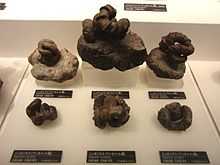Nipponites
| Nipponites Temporal range: Turonian–Santonian[1] | |
|---|---|
 | |
| Fossils of Nipponites mirabilis from an exhibit at the National Museum of Nature and Science, Tokyo, Japan | |
| Scientific classification | |
| Kingdom: | Animalia |
| Phylum: | Mollusca |
| Class: | Cephalopoda |
| Subclass: | Ammonoidea |
| Order: | Ammonitida |
| Suborder: | Ancyloceratina |
| Superfamily: | Turrilitaceae |
| Family: | Nostoceratidae |
| Genus: | Nipponites Yabe, 1904 |
| Species | |
| |
Nipponites ("stone of Nippon") is an extinct genus of heteromorph ammonites. The species of Nipponites (primarily N. mirabilis) are famous for the way their shells form "ox-bow" bends, resulting in some of the most bizarre shapes ever seen among ammonites.
The ecology of Nipponites, as with many other nostoceratids, is subject to much speculation.
Distribution
Fossils of most species are found primarily in Upper Cretaceous-aged strata of Japan. N. mirabilis is found in Conician-aged strata of Japan and possibly Turonian-aged strata in Madagascar.[2] N. bacchus is found in Upper Cretaceous Hokkaido. Two species are found exclusively outside of Japan, N. sachalinensis, which is found in Upper Cretaceous strata of Sakhalin island, and Kamchatka peninsula,[3] and N. occidentalis, which is found exclusively in Turonian-aged strata of Southern Oregon.[4]
References
- Notes
- ↑ Sepkoski, Jack (2002). "Sepkoski's Online Genus Database". Retrieved 2014-05-28.
- ↑ Makhon ha-geʹologi (Israel) (1981). Geological Survey Current Research. Ministry of Commerce and Industry, Geological Survey of Israel.
- ↑ Shigeta, Yasunari, and Haruyoshi Maeda. "Yezo Group research in Sakhalin—a historical review." National Science Museum Monographs 31 (2005): 1-24.
- ↑ Ward, Peter D., and Gerd EG Westermann. "First occurrence, systematics, and functional morphology of Nipponites (Cretaceous Lytoceratina) from the Americas." Journal of Paleontology (1977): 367-372.
- Bibliography
- Arkell, W.J.; Kummel, B.; Wright, C.W. (1957). Mesozoic Ammonoidea. Treatise on Invertebrate Paleontology, Part L, Mollusca 4. Lawrence, Kansas: Geological Society of America and University of Kansas Press.
| Wikimedia Commons has media related to Nipponites. |